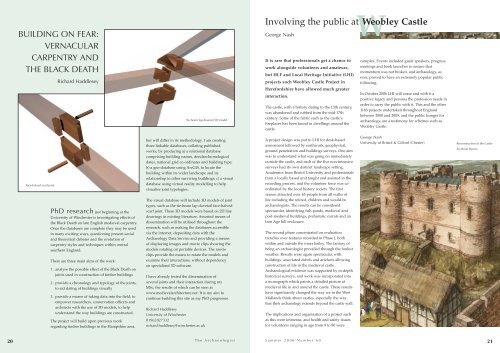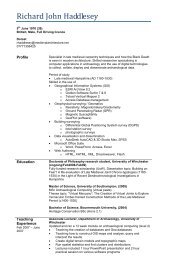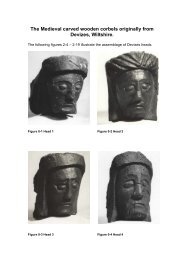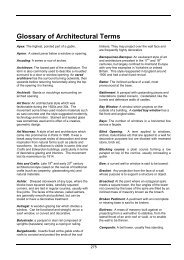The ARCHAEOLOGIST - English Late-Medieval timber-framed ...
The ARCHAEOLOGIST - English Late-Medieval timber-framed ...
The ARCHAEOLOGIST - English Late-Medieval timber-framed ...
Create successful ePaper yourself
Turn your PDF publications into a flip-book with our unique Google optimized e-Paper software.
BUILDING ON FEAR:<br />
VERNACULAR<br />
CARPENTRY AND<br />
THE BLACK DEATH<br />
Richard Haddlesey<br />
Tie beam lap dovetail 3D model<br />
Involving the public atW<br />
Weobley Castle<br />
George Nash<br />
It is rare that professionals get a chance to<br />
work alongside volunteers and amateurs,<br />
but HLF and Local Heritage Initiative (LHI)<br />
projects such Weobley Castle Project in<br />
Herefordshire have allowed much greater<br />
interaction.<br />
<strong>The</strong> castle, with a history dating to the 13th century,<br />
was abandoned and robbed from the mid-17th<br />
century. Some of the fabric such as the castle’s<br />
fireplaces has been found in dwellings around the<br />
castle.<br />
complex. Events included guest speakers, progress<br />
meetings and book launches to ensure that<br />
momentum was not broken, and archaeology, as<br />
ever, proved to have an extremely popular public<br />
following.<br />
In October 2006 LHI will cease and with it a<br />
positive legacy and persona the profession needs in<br />
order to carry the public with it. This and the other<br />
1183 projects undertaken throughout England<br />
between 2000 and 2005, and the public hunger for<br />
archaeology, are a testimony for schemes such as<br />
Weobley Castle.<br />
Face-halved scarf joint<br />
PhD research just beginning at the<br />
University of Winchester is investigating effects of<br />
the Black Death on late <strong>English</strong> medieval carpentry.<br />
Once the databases are complete they may be used<br />
in many exciting ways, questioning present social<br />
and theoretical debates and the evolution of<br />
carpentry styles and techniques within central<br />
southern England.<br />
<strong>The</strong>re are three main aims of the work:<br />
1. analyse the possible effect of the Black Death on<br />
joints used in construction of <strong>timber</strong> buildings<br />
2. provide a chronology and typology of the joints,<br />
to aid dating of buildings visually<br />
3. provide a means of taking data into the field, to<br />
empower researchers, conservation officers and<br />
architects with the use of 3D models, to help<br />
understand the way buildings are constructed.<br />
<strong>The</strong> project will build upon previous work<br />
regarding <strong>timber</strong> buildings in the Hampshire area,<br />
but will differ in its methodology. I am creating<br />
three linkable databases, collating published<br />
works, by producing a) a relational database<br />
comprising building names, dendrochronological<br />
dates, national grid co-ordinates and building type;<br />
b) a geo-database using ArcGIS, to locate the<br />
building within its wider landscape and its<br />
relationship to other surviving buildings; c) a visual<br />
database using virtual reality modelling to help<br />
visualise joint typologies.<br />
<strong>The</strong> visual database will include 3D models of joint<br />
types, such as the tie-beam lap dovetail face-halved<br />
scarf joint. <strong>The</strong>se 3D models were based on 2D line<br />
drawings in existing literature. Assorted means of<br />
dissemination will be utilised throughout the<br />
research, such as making the databases accessible<br />
via the internet, depositing data with the<br />
Archaeology Data Service and providing a means<br />
of displaying images and movie clips showing the<br />
models rotating on portable devices. <strong>The</strong> movie<br />
clips provide the means to rotate the models and<br />
examine their interactions, without dependency<br />
on specialised 3D software.<br />
I have already tested the dissemination of<br />
several joints and their interaction during my<br />
MSc, the results of which can be seen at<br />
www.medievalarchitecture.net. It is my aim to<br />
continue building this site as my PhD progresses.<br />
Richard Haddlesey<br />
University of Winchester<br />
01962827332<br />
richard.haddlesey@winchester.ac.uk<br />
A project design was put to LHI for desk-based<br />
assessment followed by earthwork, geophysical,<br />
ground penetration and buildings surveys. One aim<br />
was to understand what was going on immediately<br />
outside the castle, and each of the five non-intrusive<br />
surveys had its own distinct landscape setting.<br />
Academics from Bristol University and professionals<br />
from a locally based unit taught and assisted in the<br />
recording process, and the volunteer force was coordinated<br />
by the local history society. <strong>The</strong> first<br />
season attracted over 65 people from all walks of<br />
life including the retired, children and would-be<br />
archaeologists. <strong>The</strong> results can be considered<br />
spectacular, identifying fish ponds, medieval and<br />
post-medieval buildings, prehistoric corrals and an<br />
Iron Age hill enclosure.<br />
<strong>The</strong> second phase concentrated on evaluation<br />
trenches over features recorded in Phase I, both<br />
within and outside the inner bailey. <strong>The</strong> fantasy of<br />
being an archaeologist prevailed through the foulest<br />
weather. Results were again spectacular, with<br />
buildings, associated debris and artefacts allowing<br />
construction of life in the medieval castle.<br />
Archaeological evidence was supported by in-depth<br />
historical surveys, and work was incorporated into<br />
a monograph which paints a detailed picture of<br />
medieval life in and around the castle. <strong>The</strong>se results<br />
have significantly changed the way we in the West<br />
Midlands think about castles, especially the way<br />
that their archaeology extends beyond the castle wall.<br />
<strong>The</strong> implications and organisation of a project such<br />
as this were immense, and health and safety issues<br />
for volunteers ranging in age from 9 to 80 were<br />
George Nash<br />
University of Bristol & Gifford (Chester)<br />
Reconstruction of the Castle<br />
(by Brian Byron)<br />
20<br />
<strong>The</strong> Archaeologist<br />
Summer 2006 Number 60<br />
21





